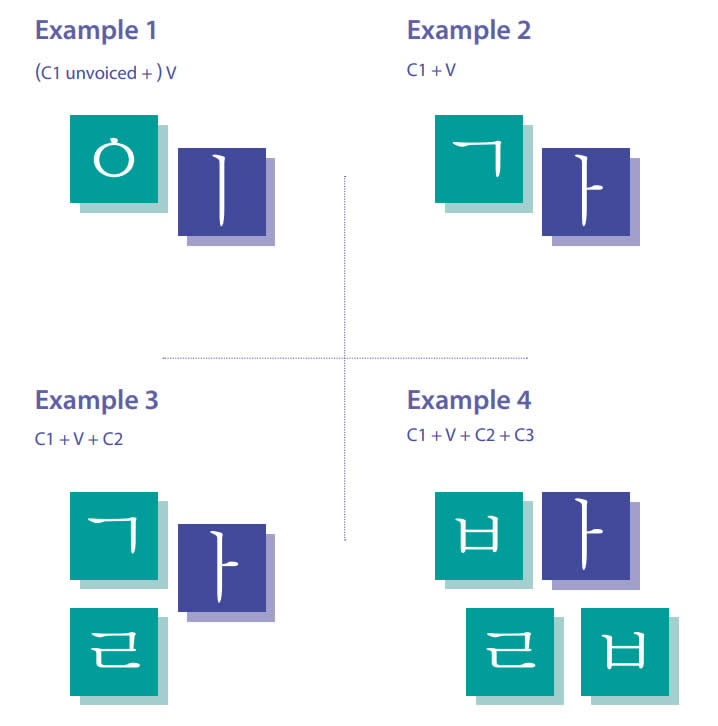Difference between revisions of "Language/Korean/Pronunciation/How-to-write-Korean-syllables"
< Language | Korean | Pronunciation
Jump to navigation
Jump to search
m (Quick edit) |
|||
| (5 intermediate revisions by 2 users not shown) | |||
| Line 1: | Line 1: | ||
[[File:Korean-Language-PolyglotClub.png|thumb]] | [[File:Korean-Language-PolyglotClub.png|thumb]] | ||
<div | <div class="pg_page_title"> How to write Korean syllables</div> | ||
__TOC__ | __TOC__ | ||
==syllables== | ==syllables== | ||
Korean writing is conceived in blocks representing syllables, each composed of an initial consonant, a (medial) vowel or a diphthong, and finally an ending composed of one or two consonants known as batchim. Consider the following examples: | Korean writing is conceived in blocks representing syllables, each composed of an initial consonant, a (medial) vowel or a diphthong, and finally an ending composed of one or two consonants known as batchim. | ||
Consider the following examples: | |||
[[File:Korean-Language-syllabe1-PolyglotClub.jpg]] | [[File:Korean-Language-syllabe1-PolyglotClub.jpg]] | ||
| Line 10: | Line 12: | ||
Some pronunciation change if followed by this particle. The word batchim (받침, literally meaning “basis, support”) refers to consonants at the conclusion of a syllable. Not all syllable blocks have one; for instance, those in examples 1 and 2 don’t have any. Example 3 has one, and example 4 has a double batchim. | Some pronunciation change if followed by this particle. The word batchim (받침, literally meaning “basis, support”) refers to consonants at the conclusion of a syllable. Not all syllable blocks have one; for instance, those in examples 1 and 2 don’t have any. Example 3 has one, and example 4 has a double batchim. | ||
==Video: Korean Syllables & Reading 받침 (batchim)== | |||
<youtube>https://www.youtube.com/watch?v=3mWNeZ9p6_I</youtube> | <youtube>https://www.youtube.com/watch?v=3mWNeZ9p6_I</youtube> | ||
==Sources== | |||
* https://www.spdbooks.org/Content/Site106/FilesSamples/9781624120688.pdf | |||
* https://polyglotclub.com/help/language-learning-tips/learn-korean-writing | |||
== | ==Other Lessons== | ||
* | * [[Language/Korean/Pronunciation/Complex-finals|Complex finals]] | ||
* [[Language/Korean/Pronunciation/Write-and-Pronounce-Korean-Vowels|Write and Pronounce Korean Vowels]] | |||
* [[Language/Korean/Pronunciation/Alphabet-and-Pronunciation|Alphabet and Pronunciation]] | |||
<span links></span> | |||
Latest revision as of 14:00, 27 March 2023
How to write Korean syllables
syllables[edit | edit source]
Korean writing is conceived in blocks representing syllables, each composed of an initial consonant, a (medial) vowel or a diphthong, and finally an ending composed of one or two consonants known as batchim.
Consider the following examples:
받침[edit | edit source]
Some pronunciation change if followed by this particle. The word batchim (받침, literally meaning “basis, support”) refers to consonants at the conclusion of a syllable. Not all syllable blocks have one; for instance, those in examples 1 and 2 don’t have any. Example 3 has one, and example 4 has a double batchim.
Video: Korean Syllables & Reading 받침 (batchim)[edit | edit source]
Sources[edit | edit source]
- https://www.spdbooks.org/Content/Site106/FilesSamples/9781624120688.pdf
- https://polyglotclub.com/help/language-learning-tips/learn-korean-writing
Other Lessons[edit | edit source]

